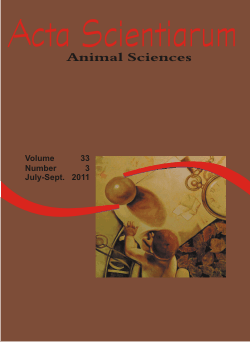<b>Leaf-to-stem ratio and bromatological characteristics of Campo-Grande stylo regrowth at five cutting ages</b> - doi: 10.4025/actascianimsci.v33i3.10981
Keywords:
phosphorus fertilization, age of regrowth, crude protein, Stylosanthes
Abstract
The aim of this research study was to evaluate the bromatological composition and leaf-to-stem ratio of Campo-Grande stylo, at five regrowth ages, with and without phosphorus. The investigation was carried out in a randomized blocks experimental design, with four replications in a 2 x 5 factorial arrangement – two levels of phosphorus (with or without) and five cutting ages (30, 35, 40, 45 and 50 days). Phosphorus was applied as a single superphosphate, equivalent to 50 kg ha-1 P2O5. The leaf-to-stem ratio (L/S) and the percentage of crude protein (CP) decreased with increasing age of regrowth, with and without phosphorus fertilization. Crude protein yield (CPY) with phosphorus fertilization increased linearly; yield without fertilization was quadratic, decreasing between 45 and 50 days of regrowth. The percentages of dry matter (DM) and neutral detergent fiber (NDF) increased with regrowth age. The percentage of acid detergent fiber (ADF) followed a quadratic trend, decreasing at the ages of 45 and 50 days. Phosphorus fertilization had no effect on L/S, CP, DM, NDF and ADF of Campo-Grande stylo. The age of regrowth of 30 and 50 days have minimal effect on the bromatological composition of Campo-Grande stylo.Downloads
Download data is not yet available.
Published
2011-03-21
How to Cite
Moura, R. L. de, Nascimento, M. do P. S. C. B. do, Rodrigues, M. M., Oliveira, M. E., & Lopes, J. B. (2011). <b>Leaf-to-stem ratio and bromatological characteristics of Campo-Grande stylo regrowth at five cutting ages</b> - doi: 10.4025/actascianimsci.v33i3.10981. Acta Scientiarum. Animal Sciences, 33(3), 249-254. https://doi.org/10.4025/actascianimsci.v33i3.10981
Issue
Section
Pasture and forage utilization
DECLARATION OF ORIGINALITY AND COPYRIGHTS
- I Declare that current article is original and has not been submitted for publication, in part or in whole, to any other national or international journal.
The copyrights belong exclusively to the authors. Published content is licensed under Creative Commons Attribution 4.0 (CC BY 4.0) guidelines, which allows sharing (copy and distribution of the material in any medium or format) and adaptation (remix, transform, and build upon the material) for any purpose, even commercially, under the terms of attribution.
Read this link for further information on how to use CC BY 4.0 properly.
0.9
2019CiteScore
29th percentile
Powered by 








































